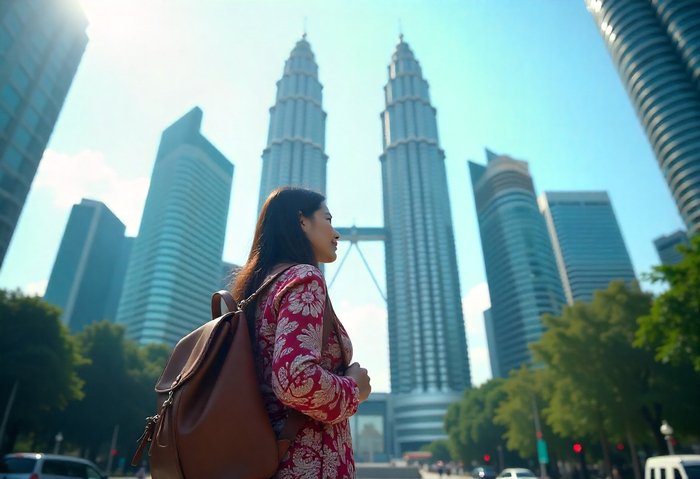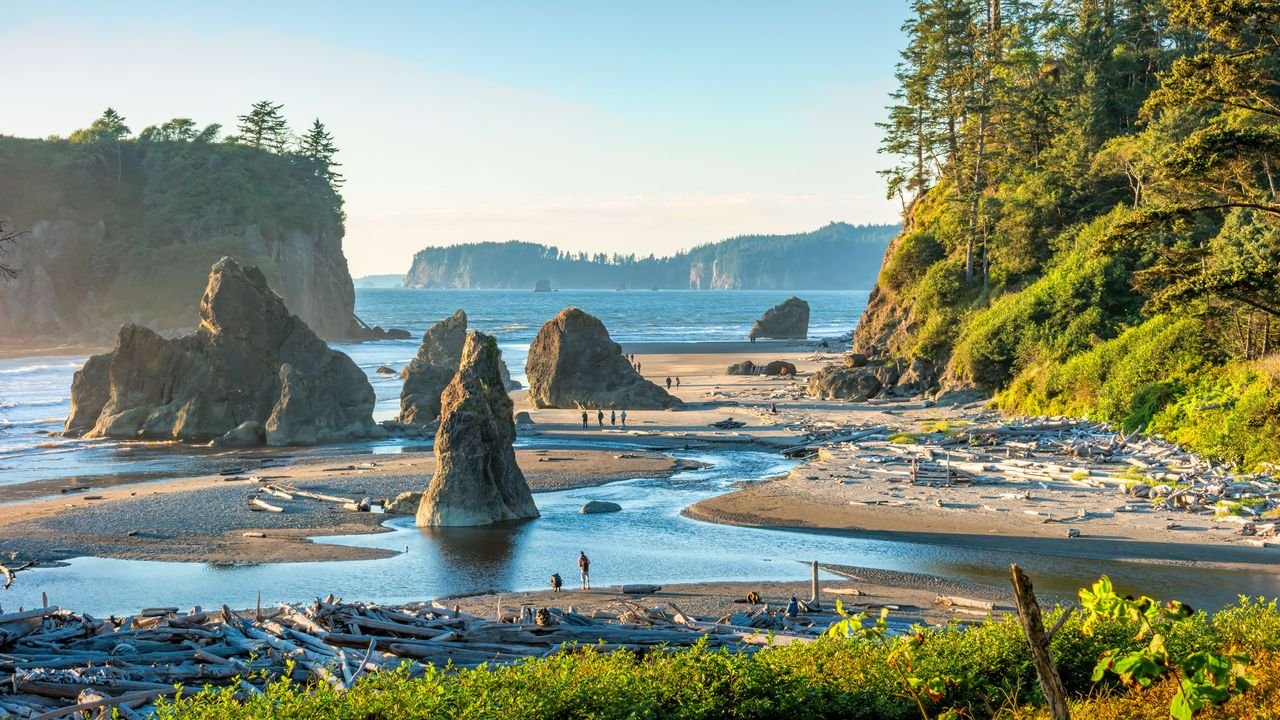Solo Travellers
Costa Rica’s nine-course meal in the sky

He handed over a San Lucas “passport”, which included another map of the country with background about each province, and opened the suitcase to reveal an adventurous assortment of appetisers: taro root chips; a cocoa butter sphere containing agua de sapo (a drink made with sugar cane, lime and ginger); mushroom-shaped butter; and a shot of chicheme (a traditional Indigenous fermented purple corn drink).
Over the next two hours, Marenco presented a nine-course tasting menu, each dish paying homage to a different province. With each course, he added insight – from local dish nicknames to stories of how geography shaped cuisine – enriching the menu with personal and cultural context.
I’d requested the vegetarian menu and began my journey with a punchy ceviche made with green apple and chayote – an alternative to the fish and piangua (black-shelled molluscs) dish – that represented Puntarenas, the province with the longest Pacific coastline. A crispy quinoa croquette atop a delicate coconut milk foam arrived at dusk, the sauce’s spicy, aromatic flavours inspired by Limón, Costa Rica’s Caribbean province. Cartago was depicted with a smoky potato dish – the province’s main agricultural product – topped with “ash” made from burnt onion powder, referencing its volcanic landscape.
San Lucas opened in 2019, but the project was years in the making. Valverde consulted with multiple experts, including Alejandra Brenes, a psychologist who specialises in gastronomic consumer behaviour and the neuroscience of sensory experiences. For San Lucas, she researched how people react to different stimuli in order to curate the experience for diners and generate curiosity. “For example, temperature, the choice of plates, the way the food is placed on them, the music, the dish’s texture, it all affects our perception of flavour,” she said, describing the end result as “a small gastronomic adventure park”.
More like this:
• Trekking Costa Rica’s wildest trails
Solo Travellers
Malaysia Leads the Way in Solo Travel by Empowering Travelers to Break Free from the Norm and Embark on Transformative, Self-Directed Journeys

Wednesday, August 6, 2025
Malaysia is emerging as a leader in the solo travel movement, offering a unique and empowering experience for those seeking to break free from traditional group tours and explore the world on their own terms. With a growing number of Malaysians choosing to travel solo, the country has become a hub for those seeking more than just a typical vacation. This shift towards self-directed journeys is driven by the desire for personal freedom, deeper self-discovery, and the opportunity to engage in experiences that are tailored to individual passions. Solo travel in Malaysia allows adventurers to immerse themselves in authentic cultural encounters, recharge mentally and emotionally, and create meaningful connections with themselves and the world around them. Through this empowering trend, Malaysia is not only shaping the future of travel but also giving travelers the chance to redefine what it means to explore the world.
A recent study has shed light on the growing trend of solo travel among Malaysians. According to the research, 60% of respondents reported having gone on multiple solo trips in the past year, with nearly one-third having taken three or more such trips. Millennials are leading the pack, comprising 38% of both current solo travelers and those intending to travel alone in the future.
This shift in travel behavior signals a growing desire for more individualized and meaningful experiences. Solo travel has become much more than a mere trend; it represents a shift in how people view vacations and self-exploration. For many, traveling alone allows them to immerse themselves in a more authentic journey, free from the expectations and group dynamics typically associated with traditional travel.
One of the most striking findings from the study is that a large majority of Malaysians who have traveled solo would encourage others to do the same. A remarkable 86% of respondents expressed that they would recommend solo travel to others, indicating that this form of travel is seen not only as enjoyable but also rewarding enough to be shared with others. This endorsement highlights how solo travelers often form a deep, positive connection with their experiences and see them as more than just a trip but as an empowering adventure.
The motivations for choosing to travel solo are multifaceted but tend to center around personal freedom and self-care. Flexibility in planning and the opportunity to recharge are some of the main reasons people are turning to solo travel. More than half of the respondents (56%) cited the ability to create their own itinerary as a key motivator. Unlike group travel, where compromises are necessary and plans are often set in advance, solo travelers enjoy complete control over their schedules and destinations. This freedom allows them to travel at their own pace and engage in the experiences they find most meaningful.
In addition to flexibility, 53% of solo travelers highlighted the chance to take a break and focus on their own well-being as another significant reason for choosing to travel alone. Solo journeys provide the mental space needed to relax, unwind, and focus on personal growth. Whether through quiet reflection in a serene destination or indulgence in self-care activities, solo travel gives individuals the chance to reconnect with themselves outside of the demands and distractions of everyday life.
Another key aspect driving the rise of solo travel is the desire to pursue personal passions. Almost half (47%) of the solo travelers surveyed indicated that traveling alone gave them the space to engage in hobbies or activities they love. This figure surpasses the regional average of 43%, emphasizing a shift toward more fulfilling, self-directed travel experiences. For many, the ability to enjoy a trip at their own pace allows them to fully embrace personal interests—whether that’s exploring historical sites, enjoying outdoor adventures, or discovering local cultures.
The freedom to explore without the constraints of a group itinerary is one of the most appealing aspects of solo travel. This autonomy allows travelers to savor the journey and take the time to enjoy the small details—whether it’s lingering in a museum, tasting local delicacies, or wandering through charming streets without a specific destination in mind. Solo travel empowers individuals to engage in their surroundings on their own terms, making each experience feel more intimate and personal.
This growing trend toward solo travel reflects a broader cultural shift in how people approach vacations and leisure time. More than ever, individuals are seeking meaningful experiences that go beyond just escaping from work or the daily grind. They view travel as an opportunity for personal enrichment—an experience that can contribute to their growth, well-being, and self-discovery. Solo travel, in particular, offers a unique chance to make these experiences happen in a more intentional and fulfilling way.
As solo travel continues to gain popularity in Malaysia, the motivations behind it are becoming clearer. Beyond the desire for adventure or novelty, many solo travelers are drawn to the opportunity for personal growth, reflection, and self-care. For them, traveling alone isn’t just about being physically away from home—it’s about embarking on a transformative journey that nurtures their mind and spirit.
Malaysia is leading the solo travel movement by offering travelers the freedom to break free from traditional tours and embark on transformative, self-directed journeys that prioritize personal discovery and authentic experiences.
This surge in solo travel is not only reshaping the way people vacation but also how they perceive their relationship with the world around them. It’s a chance to learn more about oneself, pursue personal passions, and engage with new cultures in a meaningful way. As more Malaysians embrace the freedom and enrichment that solo travel offers, it seems likely that this trend will continue to grow, becoming a central part of the modern travel landscape.
Solo Travellers
The Best Places to Visit in December, From Banff to Belize

For the best places to visit in December, one must think creatively. Certainly, you’d be free and well-advised to visit a snow-filled escape for some time on the slopes and sitting by the fire with a cup of hot chocolate. But also there are places in the world where the chill of winter is an unknown charm—think tropical islands and stretches of sand along the Equator that have never, ever seen a flake of snow. For that matter, in December, the Southern Hemisphere welcomes summer and Christmas in shorts and flip-flops are the standard. No matter where you go in the last month of the year (you’re certainly the proactive traveler if you’re already planning six months ahead!), you’ll find warmth or coziness, especially with our recommendations. Here are the 13 best places to travel in December, from seaside adventures with sharks to après-ski-and-spa vibes after a day of crushing powder.
(For more ideas, find our full list of the best places to go in 2025 here.)
This article has been updated with new information since its original publish date.
Solo Travellers
The US Is Leaving UNESCO: Here’s What Comes Next

How will this affect travel to the US?
The US withdrawal is set to take place on December 31, 2026, and the US will remain a full member of UNESCO until then. An active membership in UNESCO is not a requirement for having a site listed, and the 26 existing World Heritage sites in the US will not lose their UNESCO designation, according to a UNESCO spokesperson.
However, the US withdrawal will mean a loss of American influence around what future UNESCO projects are supported and funded. At the moment, 17 sites in the US are on the “tentative list” for consideration for inscription on the World Heritage List. Concerns about their prospects post-withdrawal have been raised at places like Serpent Mound in Ohio, where local media reported that the site could now “see years of delay in World Heritage nomination.”
Leigh Barnes, President of the Americas for Intrepid Travel, a small-group adventure tour company that frequently incorporates UNESCO sites into its itineraries, raised concerns about the potential impacts. “Stepping away from UNESCO risks reducing critical international support, funding, and technical expertise for their preservation—in areas like ecosystem protection, education leadership, and cultural heritage stewardship,” he says.
Barnes was particularly concerned about how the move could further impact the National Park Service, which manages most of the US World Heritage sites, and is already facing what he calls “severe domestic threats” from staffing cutbacks and funding cuts. Nearly 25% of permanent National Park Service staff has already been lost in 2025.
“The National Park Service was known for its incredible expertise, its historians, its archeologists, its climate change specialists, its wildlife biologists,” says Barrett. “And all of them contributed to conserving the values that the parks had, but particularly the World Heritage park values.”
Will international UNESCO sites be impacted?
Azoulay said the US withdrawal was expected by UNESCO, and that steps had been taken to diversify the agency’s funding sources since the US first pulled out in 2018. US contributions now represent 8% of UNESCO’s total budget.
Azoulay added that UNESCO intends to continue carrying out its mission “despite inevitably reduced resources,” and that organization is not considering layoffs at this time.
A UNESCO spokesperson tells Condé Nast Traveler that the agency does not anticipate changes for the visitor experience at World Heritage sites as a direct result of the US withdrawal, and that US travelers will always be welcome to UNESCO sites. “The relationship between UNESCO and the American people is not stopping,” the spokesperson says.
-

 Brand Stories2 weeks ago
Brand Stories2 weeks agoBloom Hotels: A Modern Vision of Hospitality Redefining Travel
-

 Brand Stories2 weeks ago
Brand Stories2 weeks agoCheQin.ai sets a new standard for hotel booking with its AI capabilities: empowering travellers to bargain, choose the best, and book with clarity.
-

 Destinations & Things To Do2 weeks ago
Destinations & Things To Do2 weeks agoUntouched Destinations: Stunning Hidden Gems You Must Visit
-

 Destinations & Things To Do2 weeks ago
Destinations & Things To Do2 weeks agoThis Hidden Beach in India Glows at Night-But Only in One Secret Season
-

 AI in Travel2 weeks ago
AI in Travel2 weeks agoAI Travel Revolution: Must-Have Guide to the Best Experience
-

 Brand Stories1 month ago
Brand Stories1 month agoVoice AI Startup ElevenLabs Plans to Add Hubs Around the World
-

 Brand Stories4 weeks ago
Brand Stories4 weeks agoHow Elon Musk’s rogue Grok chatbot became a cautionary AI tale
-

 Brand Stories2 weeks ago
Brand Stories2 weeks agoContactless Hospitality: Why Remote Management Technology Is Key to Seamless Guest Experiences
-

 Asia Travel Pulse1 month ago
Asia Travel Pulse1 month agoLooking For Adventure In Asia? Here Are 7 Epic Destinations You Need To Experience At Least Once – Zee News
-

 AI in Travel1 month ago
AI in Travel1 month ago‘Will AI take my job?’ A trip to a Beijing fortune-telling bar to see what lies ahead | China

You must be logged in to post a comment Login